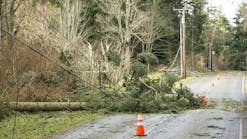How Quantum AI Can Transform Grid Disaster Resilience and Preparedness
Grid Disaster Resilience and Preparedness: Challenges and Significance
The concept of enhancing grid disaster resilience and preparedness focuses on identifying, developing, and implementing strategies for limiting the impact of extreme events on the power grid, events that would otherwise cause large-area, long-duration outages. These outages would potentially outspread multiple service areas and critical infrastructures, including natural gas, water, telecommunications, transportation, and emergency services.
Electric utilities invest heavily on proactive and preventive measures to extreme events, including but not limited to, hardening the grid through transmission and distribution (T&D) upgrades and tapping into the potential of new technologies such as microgrids. The growing concern over extreme events, mostly as a direct result of climate change, has underscored the need for expanding traditional power grid preparedness, response, and recovery practices to handle the associated challenges of these events.
Considering the growing expectations of customers for uninterrupted service and the commitment of electric utilities to implement preventive measures and substantially reduce the frequency and duration of interruptions, it is more essential than ever to create a systematic modeling structure and effective decision making to reach desired levels of grid resilience. However, incremental improvements in grid analytics cannot handle the changes taking place in the grid today. As mathematical challenges are enormous and data is becoming the epicenter of modern decision making, substantial progress needs to be made with integrative methods that draw on emerging analytics and computing technologies.
Resilience modeling involves thousands to millions of variables and equations, and requires improvements in the efficiency and precision of existing models, incorporating more security and physical impacts, and describing uncertainty. Therefore, it is necessary to perform parallel information processing and rapid search over unordered sets of data while making predictions and decision making faster and more accurate. New mathematical methods need to be developed and implemented in power grid analytics and computing to enable this vital transformation. Such an application can be driven from quantum computing and the mining of resolved computational/observational data.
Quantum Artificial Intelligence: A Way Forward
Quantum artificial intelligence (QAI) is a state-of-the-art enabling technology that can be leveraged to enable revolutionary transitions in achieving computationally efficient and economically viable models in designing more resilient power grids. QAI is an interdisciplinary field that concentrates on creating quantum algorithms for enhancing computational tasks within artificial intelligence (AI) domain. Fueled by increasing quantum computing power and algorithmic advances, QAI techniques have become powerful tools for finding patterns in data. Existing efforts on QAI focus on tasks such as image processing, speech recognition, strategy optimization, design and analysis of molecules for drug development in healthcare and medicine research, along with growing applications in the information technology (IT) industry.
A quantum computer encodes the information by quantum bits or qubits. Like a regular bit, a qubit could be either 0 or 1, but unlike a regular bit, a qubit may exist simultaneously in both states. The potential power of quantum computing is in the superposition and entanglement of states, allowing exponentially many computations to be done in parallel and to perform computations that are much more efficient than classical algorithms.
Superposition represents the capability of a quantum system to be in multiple states at the same time. In other words, because of quantum mechanics, particles can exist across all possible states at the same time, specified as a superposition of states. Entanglement represents the ability of quantum particles, such as atoms, to be linked in perfect unison in different spaces, which means when something is changed about one particle, it can impact the other entangled particle even if they are separated by a great distance. Certain difficult problems that are impossible for classical computers to process can be solved efficiently by a quantum computer because of these two quantum behaviors.
A great deal of AI applications attempt to confront and cope with problems that are exceedingly heavy for classical algorithmic approaches, such as NP-hard, which is indeed the case for grid disaster resilience and preparedness. It is proven that QAI can significantly lessen time complexity to a polynomial range, which denotes that a quantum algorithmic process is capable of solving AI problems in a more efficient and faster manner, particularly in the case of a power grid, by helping address resilience modeling and analysis challenges.
How to Make It Happen
Analysis of grid disaster resilience and preparedness in dealing with extreme events is a challenging problem that spans several scientific disciplines. It is necessary to conduct comprehensive research on this emerging technology as an enabler of the green, reliable, resilient, and secure grid of the future. A growing number of active technologies, such as microgrids, and the resulting complexity call for revisiting traditional computing methods and investing in innovative approaches that can address the needs of a modernized power grid.
QAI offers mathematical and computational advances that could have potentially significant impacts on revolutionizing grid resilience practices. This is enabled by conducting a coordinated assessment of the numerous resilience metrics for T&D systems, along with weather effects and socioeconomic impacts, to operationalize these metrics within the grid of the future. The key, as always, is to bridge between multiple disciplines, including engineering, physics, and computer science, and to enable close collaborations to drive new frontiers of knowledge.


